AMD Kaveri Review: A8-7600 and A10-7850K Tested
by Ian Cutress & Rahul Garg on January 14, 2014 8:00 AM ESTIntegrated GPU Performance: BioShock Infinite
The first benchmark in our test is Bioshock Infinite, Zero Punctuation’s Game of the Year for 2013. Bioshock Infinite uses the Unreal Engine 3, and is designed to scale with both cores and graphical prowess. We test the benchmark using the Adrenaline benchmark tool and their three default settings of Performance (1280x1024, Low), Quality (1680x1050, Medium/High) and Xtreme (1920x1080, Maximum) noting down the average frame rates and the minimum frame rates.
Bioshock Infinite, Performance Settings
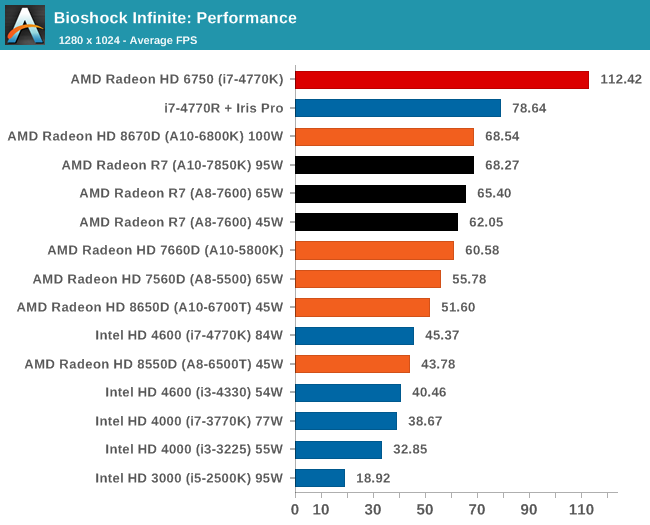
For BI: Performance we see the Iris Pro being top of the IGPs, although the next six in the list are all AMD. The Kaveri cores are all between the 6800K and 5800K for this test, and all comfortably above 60 FPS average.
Bioshock Infinite, Quality Settings

For the quality settings, the Iris Pro starts to struggle and all the R7 based Kaveri APUs jump ahead of the A10-6800K - the top two over the Iris Pro as well.
Bioshock Infinite, Xtreme Settings
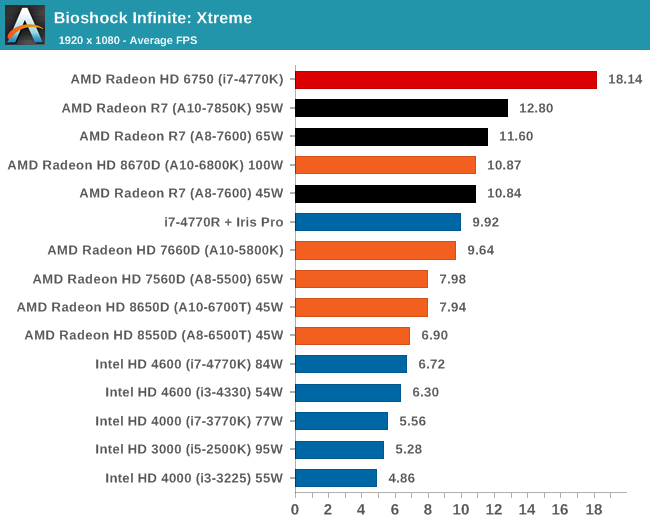
The bigger the resolution, the more the Iris Pro suffers, and Kaveri takes three out of the top four IGP results.
Integrated GPU Performance: Tomb Raider
The second benchmark in our test is Tomb Raider. Tomb Raider is an AMD optimized game, lauded for its use of TressFX creating dynamic hair to increase the immersion in game. Tomb Raider uses a modified version of the Crystal Engine, and enjoys raw horsepower. We test the benchmark using the Adrenaline benchmark tool and their three default settings of Performance (1280x1024, Low), Quality (1680x1050, Medium/High) and Xtreme (1920x1080, Maximum) noting down the average frame rates and the minimum frame rates.
Tomb Raider, Performance Settings
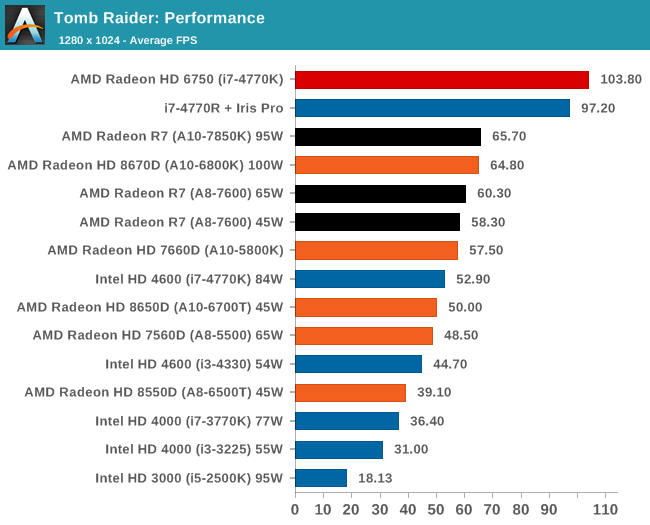
The top IGP for Richland and Kaveri are trading blows in TR.
Tomb Raider, Quality Settings

The Iris Pro takes a small lead, while the Kaveri 95W APU show little improvement over Richland. The 45W APU however is pushing ahead.
Tomb Raider, Xtreme Settings
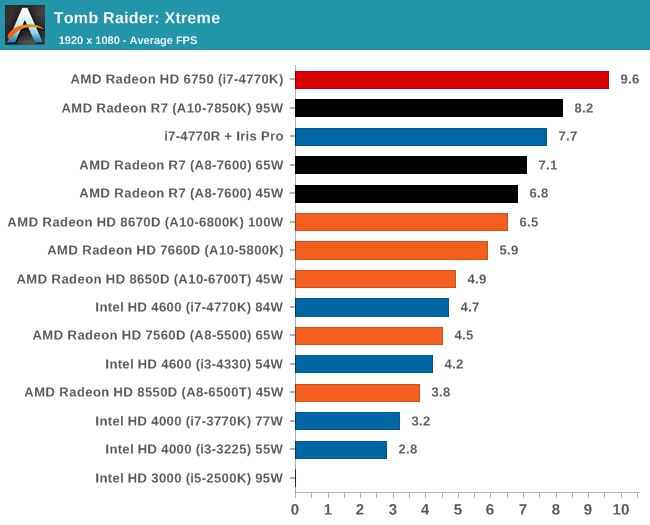
At the maximum resolution, the top Kaveri overtakes Iris Pro, and the 45W Kaveri it still a good margin ahead of the A10-6700T.
Integrated GPU Performance: F1 2013
Next up is F1 2013 by Codemasters. I am a big Formula 1 fan in my spare time, and nothing makes me happier than carving up the field in a Caterham, waving to the Red Bulls as I drive by (because I play on easy and take shortcuts). F1 2013 uses the EGO Engine, and like other Codemasters games ends up being very playable on old hardware quite easily. In order to beef up the benchmark a bit, we devised the following scenario for the benchmark mode: one lap of Spa-Francorchamps in the heavy wet, the benchmark follows Jenson Button in the McLaren who starts on the grid in 22nd place, with the field made up of 11 Williams cars, 5 Marussia and 5 Caterham in that order. This puts emphasis on the CPU to handle the AI in the wet, and allows for a good amount of overtaking during the automated benchmark. We test at three different levels again: 1280x1024 on Low, 1680x1050 on Medium and 1920x1080 on Ultra. Unfortunately due to various circumstances we do not have Iris Pro data for F1 2013.
F1 2013, Performance Settings
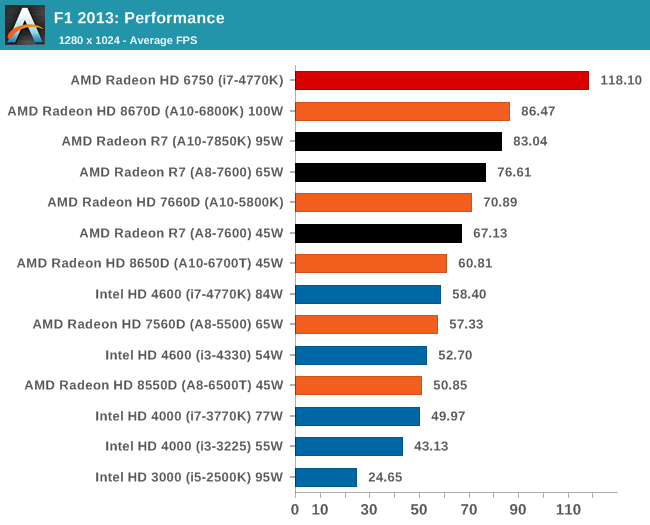
F1 likes AMD here, although moving from Kaveri to Richland at the high end seems a bit of a regression.
F1 2013, Quality Settings
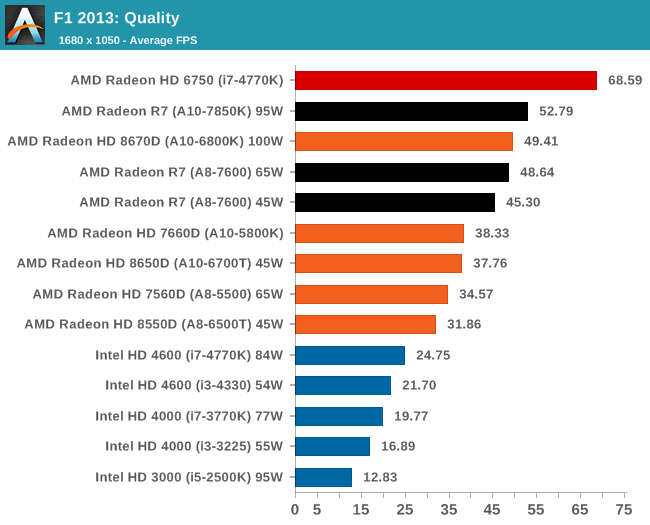
Similarly in the Quality settings, none of the Intel integrated graphics solutions can keep up with AMD, especially Kaveri.
F1 2013, Xtreme Settings

On extreme settings, at 1080p, the top Kaveri APU manages to hit over 30 FPS average during the benchmark. The other A8 Kaveri data is not too far behind.










380 Comments
View All Comments
jaydee - Tuesday, January 14, 2014 - link
I just don't "get" adding three $300 Intel CPU's to a review of 3 sub $200 AMD CPU's. We all know, or can find out how i7 SB, IB, Haswell compare to each other. I can see adding one of these CPUs to show a baseline of how AMDs top-of-the-line compares against Intels (albiet at very different price points), but having all three of them gives the impression that you want to make sure everyone knows who's boss...Is there going to be an update on power draw? I'm really curious to see what the 45W Kaveri draws (idle and full power) considering it is so competitive with the 95W Kaveri.
jaydee - Tuesday, January 14, 2014 - link
I stand corrected, four $300+ Intel i7 CPUs in this comparison, not three. And two Intel CPU's that are actually in the price range of the AMDs. It feels as if to do this review, AT just cobbled together whatever was laying around instead of being intentional about putting together the best test bench possible to compare the review product against its real competitors.It's really a shame, because the commentary, the in-depth look at the architecture and the conclusions are outstanding; no website out there has tech writers as good and do as thorough of a job as Anandtech. The fact that the test benches are just after-thoughts in some of these reviews are really disappointing.
UtilityMax - Tuesday, January 14, 2014 - link
I think this was mentioned somewhere in the beginning of the review. Intel likes to have the i7 reviewed instead of other parts, so the send the i7 CPUs to everyone. This is kind of like what the car makers do. Most people just buy a reasonably priced, mid-spec car model. However, the journos always get to review these ridiculously over-optioned cars, that hardly sell, like the $35 Ford Fusions, even though the base car sells for 10 grand less.jaydee - Tuesday, January 14, 2014 - link
I am well aware that when having the choice, Intel would rather you review a $340 Intel CPU against a $179 AMD CPU. But is there not any way, given the ad revenue of Anandtech, to obtain a $190-200 mid-range Intel i5 CPU (such as the i5-4440) in order to have a relevant test bench for an eagerly anticipated AMD mid-range CPU launch?srkelley - Tuesday, January 14, 2014 - link
"...do any AnandTech readers have an interest in an even higher end APU with substantially more graphics horsepower?"Yes, oh yes! I'm letting the APU be the core of my system build in a few months and plan to upgrade as needed. I'd like a simple solution like an APU instead of having to go with a discrete card right away. If it lets me spend more on ram and other things, keep the psu and power draw low I'm happy. The most demanding game that I play right now is the Witcher 2. Eventually I will have to go discrete for Star Citizen and the Witcher 3 but if I can get solid enough results with a high powered apu then I'll simply jump to that instead.
Conduit - Tuesday, January 14, 2014 - link
This has been a long time coming thanks to Always Major Delays (AMD). Even know they can't get their sh!t together.nissangtr786 - Tuesday, January 14, 2014 - link
http://techreport.com/review/25908/amd-a8-7600-kav...The fpu still not improved miles still behind intel.
http://browser.primatelabs.com/geekbench3/326781
http://browser.primatelabs.com/geekbench3/321256
A5 - Tuesday, January 14, 2014 - link
"do any AnandTech readers have an interest in an even higher end APU with substantially more graphics horsepower? "Maybe in the context of a Steam Machine? But for my main gaming PC, no way. Maybe something they can try out after the next die shrink if SteamOS really takes off.
Xajel - Tuesday, January 14, 2014 - link
I believe the main reason for AMD to not have a new FX is SOI process.. it was okay in it's glory days, but it can't keep it up with bulk silicon...They want to increase the clock at least but they're trapped with 32nm SOI, and why not moving toward 28nm or lower SOI because I think that AMD is already working to convert it's entire CPU's to Bulk Silicon, so it's not logical to make a new design for still not ready yet 28nm or lower SOI while they are already designing the new core for bulk silicon.. knowing that both SOI and bulk require a complete redesign of the silicon just to convert from one to another... so it's not even logical to convert Pilediver or maybe even Steamroller to bulk silicon for only one year while they're working on the next architecture which will be Bulk Silicon...
jimjamjamie - Thursday, January 16, 2014 - link
That makes sense, I was very confused as to why AMD were not going to refresh the FX line - even if HSA is the future for AMD, I presumed new FX sales throughout this year would have helped things along.Perhaps it wasn't worth the cost, but at the same time AMD could really do with keeping the fanboys on side.